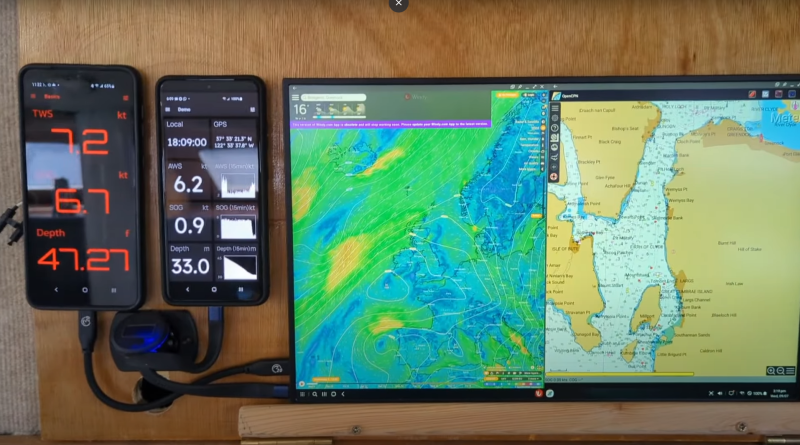[Tom] has taken a DIY approach to smart sailing with a Raspberry Pi as the back end to the navigation desk on his catamaran, the SeaHorse. Tucked away neatly in a waterproof box with a silicone gasket, he keeps the single board computer safe from circuit-destroying salt water. Keeping a board sealed up so tightly also means that it can get a little too warm. Because of this he under-clocks the CPU so that it generates less heat. This also has the added benefit of saving on power which is always good when you aren’t connected to the grid for long stretches of time.
A pair of obsolescent phones and a repurposed laptop screen provide display surfaces for his navdesk. With these screens he has weather forecasts, maps, GPS, depth, speed over ground — all the data from all the onboard instruments a sailor could want to stream through a boat’s WiFi network — at his fingertips.
There’s much to be done still. Among other things, he’s added a software defined radio to the Pi to integrate radio monitoring into the system, and he’s started experimenting with reprogramming a buoy transmitter, originally designed for tracking fishing nets, so that it can transmit his boat’s location, speed and heading instead.
The software that ties much of this system together is the open source navigational platform OpenCPN which, with its support for third-party plugins, looks like a great choice for experimenting with new gadgets like fishing net buoy transmitters.
For more nautical computing fun check out this open source shipboard computer, and this data-harvesting, Arduino-driven buoy.
Thanks to [Andrew Sheldon] for floating this one our way.















Hi this is Tom from this video.
Thanks hackday for highlighting my raspberry pi powered sailboat project.
I am going to be posting regular updates on my Youtube channel “Sailing Seahorse” please subscribe which would really help me keep posting.
Upcoming projects:
M5Dial boat info system
Espruino bangleJS open source watch boat internments
A new solar power and battery system controlled by home assistant
remote Lora Meshtastic anchor alarm
Thanks
Tom
Hi Tom,
I offered you some autopilot hardware on your YouTube vid, and I saw your reply. I have a few options for you, all are built around PyPilot. How can we talk privately? One option (but open to others) might be the Raspberry Pi Boat Monitoring discord here: https://discord.gg/acJZrhKc
Good to see old cell phones put to use. Need to see more of this kind of hacking. Nice work!
Indeed, given how powerful they are it’s surprising we don’t see them used in place of Pi’s or even Arduinos more often – I guess the barrier to getting something working on them without the obsolete OS complaining is a bit high and IO is minimal.
Tidy setup! I like the repurposed mobile phones. Other complementary Open Source projects to check out are Signal K and Openplotter.
And yes, those net buoys are not legal. Even if you flout official certification, these are transmit only devices and will ignore the protocol for allocation of time slots, which is fundamental to AIS. This leads to transmitters talking over each other, disrupting communication in busy areas. Maiana is/was an Open Source projects that does it right.
Here in the US the FCC and Coast Guard have a strong opinion about net buoys:
https://www.navcen.uscg.gov/sites/default/files/pdf/AIS/FCC_DA_18_1211A1_FISH_NET_BUOYS.pdf
Thanks Adrian, I was thinking this may be the case I will not be switching on this Chinese fishing float AIS. You lean buy getting advice from each other.
Thankyou for your help.
Tom
Please post comments on open source legal AIS solutions in the comments on my youtube channel “sailing Seahorse” https://www.youtube.com/@Tom-seahorse
I have updated my youtube description to say I will not be using the orange Chinese AIS and linked here for why. I will mention this a fail in a future video.
LORAN-C or riot
The open source watch project is doing well and can be found here:
https://banglejs.com/